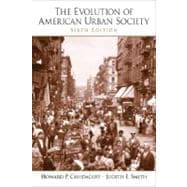
Note: Supplemental materials are not guaranteed with Rental or Used book purchases.
Purchase Benefits
What is included with this book?
| Preface | p. ix |
| Urban America in the Colonial Age, 1600-1776 | p. 1 |
| Urban Beginnings | p. 1 |
| Problems of Growth | p. 10 |
| The Social Mosaic | p. 16 |
| Cities in the American Revolution | p. 27 |
| Bibliography | p. 35 |
| Notes | p. 36 |
| Commercialization and Urban Expansion in the New Nation, 1776-1860 | p. 37 |
| The Commercial Revolution | p. 37 |
| Westward Expansion | p. 40 |
| Beginnings of Urban Industrialism | p. 45 |
| Societal Effects of Economic Change | p. 47 |
| Servicing the City | p. 52 |
| Bibliography | p. 61 |
| Notes | p. 62 |
| Life in the Walking City, 1820-1860 | p. 63 |
| The Walking City | p. 63 |
| Social Complexity and Contested Terrain | p. 67 |
| Cities and the Civil War | p. 78 |
| Bibliography | p. 81 |
| Notes | p. 83 |
| Industrialization and the Transformation of Urban Space, 1850-1920 | p. 84 |
| The Growth of Mass Transit | p. 84 |
| Spatial Segregation and the Beginning of Urban Sprawl | p. 92 |
| The Quickening Pace of Industrialization | p. 108 |
| Bibliography | p. 113 |
| Notes | p. 114 |
| Newcomers and the Urban Core, 1850-1920 | p. 115 |
| Migration, Old and New | p. 115 |
| Housing and Health | p. 126 |
| Coping with Inner-City Life | p. 133 |
| Patterns of Social Mobility | p. 142 |
| Bibliography | p. 149 |
| Notes | p. 151 |
| City Politics in the Era of Transformation | p. 152 |
| Origins of the Machine | p. 152 |
| Structure and Functions of the Machine | p. 154 |
| Some Notable Cases | p. 158 |
| City Governance and Municipal Reform | p. 166 |
| Goals and Tactics of Municipal Reform | p. 168 |
| Bibliography | p. 174 |
| Refashioning the Social and Physical Environment | p. 176 |
| Impulses of Social Reform | p. 176 |
| Remedies of Social Reformers | p. 180 |
| Planning and Engineering the City | p. 191 |
| Reform Becomes Progressivism | p. 195 |
| The Rise of Urban Liberalism | p. 198 |
| Bibliography | p. 201 |
| Notes | p. 202 |
| Cities in an Age of Metropolitanism: The 1920s and 1930s | p. 203 |
| New Urban Growth | p. 203 |
| Suburbanization and Metropolitanism | p. 208 |
| Cities and Consumer Culture | p. 215 |
| Cities as a Cultural Battleground | p. 219 |
| Urban Politics in the 1920s | p. 227 |
| The Great Depression | p. 228 |
| Political and Social Life in the 1930s | p. 240 |
| Bibliography | p. 246 |
| Notes | p. 248 |
| The Politics of Growth in the Era of Suburbanization, 1941-1974 | p. 249 |
| The Impact of World War II on Cities | p. 249 |
| Spatial Patterns of Postwar Growth | p. 253 |
| Reshaping Downtown: Progrowth Coalitions, Urban Renewal, and Their Consequences | p. 259 |
| Currents of Protest | p. 265 |
| New Political Alignments | p. 272 |
| New Suburban Realignments | p. 274 |
| Signposts of Change | p. 277 |
| Bibliography | p. 280 |
| Notes | p. 282 |
| The Fate of the Modern American City | p. 283 |
| Fiscal Crisis and the Uncertainty of Federal Urban Policy | p. 284 |
| Ronald Reagan, George H. W. Bush, and Neglect as a Panacea | p. 288 |
| The Clinton Years: Further Neglect | p. 293 |
| The Social Costs of Widening Income Inequality and Urban Neglect | p. 296 |
| New Urban Neighbors | p. 298 |
| Edge City and Inner City | p. 302 |
| Into the Twenty-First Century | p. 306 |
| Bibliography | p. 310 |
| Note | p. 311 |
| Photo Credits | p. 312 |
| Index | p. 314 |
| Table of Contents provided by Rittenhouse. All Rights Reserved. |
The New copy of this book will include any supplemental materials advertised. Please check the title of the book to determine if it should include any access cards, study guides, lab manuals, CDs, etc.
The Used, Rental and eBook copies of this book are not guaranteed to include any supplemental materials. Typically, only the book itself is included. This is true even if the title states it includes any access cards, study guides, lab manuals, CDs, etc.